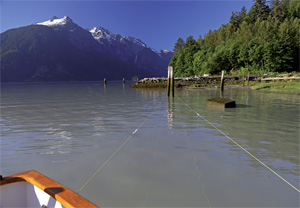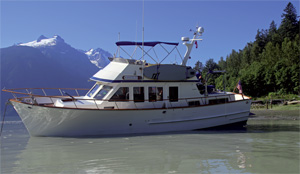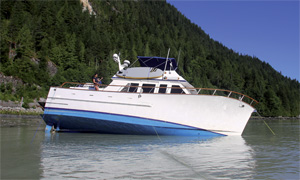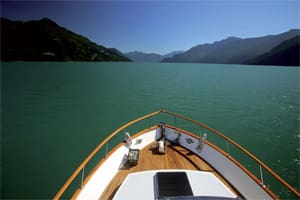Looking to find a new place to explore on Shockles, our 43-foot Ocean Alexander power voyaging boat, we pored over the charts and guidebooks while planning a cruise to Desolation Sound in British Columbia, Canada. We spotted Bute Inlet, which lies just above the well-traveled and charted Desolation Sound. It is rarely mentioned as a “must see” place to visit, yet it looks amazing.
The inlet leads to the headwaters of Mount Waddington and my husband Eric said, “We gotta go there!” He went on to explain that at 13,186 feet, Mount Waddington was one of the most remote and challenging peaks in Canada, and indeed had only been climbed a handful of times. It was at this point I should have remembered Eric’s three phrases about power voyaging: “How bad could it be?”, “What were we thinking?” and, “See, that wasn’t so bad.”
We did as much research on Bute Inlet as we could find, which wasn’t a lot. From what we could determine, 1) not many people go there; 2) there are no cozy coves or bays in which to safely anchor; 3) there is basically no protection from the wind; 4) in most places the shore drops off to 2,000 feet deep in a matter of 100 feet. One book described it, saying, “murky waters, shifting silt and hidden debris make anchoring hazardous.” Not to mention the notorious katabatic winds that roar down the Homathko Icefield, through the Homathko River Canyon and straight out into Waddington Harbor at the head of Bute Inlet. “How bad could it be?”
 |
|
Debbie Lynn and her husband Eric Sanford moored their Ocean Alexander 43 Shockles with an anchor and by tying the stern to two old pilings. |
|
Eric Sanford |
In early July, we headed north from Anacortes, Washington, in Shockles and five days later settled into a snug anchorage in the Octopus Islands, just a few miles from the entrance of the 35-mile-long Bute Inlet. Like all of Desolation Sound, it was spectacular.
Our choices for the route into the inlet were either to easily cruise through the wide channel to the east and into the main inlet, or sneak in the back way through the Cordero Channel that was guarded by two sets of notoriously tricky and dangerous rapids. Of course, my husband had to choose the rapids.
An hour too late
All the guidebooks and charts warned not to attempt this passage during anything but slack water, which at times could only last 20 minutes. The moon was full, the tides were high and this was indeed one of those times. The first challenge was Yuculta Rapids with a current up to 10 knots and “dangerous whirlpools and overfalls,” as described in the books. We checked our tide tables against the time and, of course, we were an hour too late — according to the guidebooks — to safely go through. I saw that look in Eric’s eyes: we were going in.
Shockles lurched and twisted her way through the swirling water as Eric eddy-hopped up the channel in the opposing current. A long 15 minutes later, we slipped into the main channel. Now it was an hour and a half after slack and the only way out was through the Arran Rapids, a narrow slot in the rock with 14-knot currents and “a truly fearsome whirlpool” at the end. We headed straight in. How bad could it be?
Eric expertly maneuvered Shockles through the rushing whitewater. He was able to grab a line between the eddies even as we were accelerating to 15 knots. With a few minutes of excitement as Shockles fought the surging current, we were through and promptly dismissed out into Bute Inlet.
Bute Inlet is stunning; soon after you enter, the water turns from deep blue to turquoise as the glacier water mixes with the sea. The scenery is so beautiful you would be hard-pressed to find the words. The sky was brilliant blue, the water changing to sage green, and thousand-foot rock walls rose out of the water to meet the tumbling blue glacier ice that capped the peaks all around. Complex waterfalls, cavorting dolphins and seals, soaring eagles and ospreys complete this passage. We were totally alone and it was so serene; I can say in all honesty, what we experienced was a slice of heaven — if there is such a place.
Entering Waddington Harbor, we scouted the bay to find a suitable location to drop the hook. Referring back to our books, one said, “temporary anchorage only,” and another said, “a couple of places to stay on the NW side.” The end. In essence, the guidebooks might as well just say “good luck.”
Tied to old pilings
With the winds light and the seas calm, we located some old pilings (an old log boom) off the northwest side of the harbor that seemed promising. We did a couple of laps, slowed her down and Eric found a good place to drop the anchor. The depth sounder read 45 feet — seemed reasonable. Except that we were 40 feet from shore, and another 20 feet off our bow it was more than 100 feet deep. So, in essence, we were on the edge of an underwater cliff.
Eric’s theory was that we drop the anchor over the edge and then stern-tie to one of the pilings to hold us in place. That way we couldn’t be pulled further from shore and if the wind pushes us onshore, the anchor will bite increasingly hard as it is pulled steeply uphill.
 |
|
Since water depth forced them to anchor so close to shore, when the tide ebbed Shockles went aground on the ledge. |
|
Eric Sanford |
Eric pulled out our big spool of trusty Dyneema, looped it around the piling and cleated it back to Shockles for a stern tie. This line is no bigger than sewing thread — okay, it is really 6mm line that can hold up to 5,000 pounds —but to me, it looks like decorative ribbon. Soon we were secure.
We launched our tender and headed up the totally opaque Homathko River to explore and take pictures of Mount Waddington. After an hour of fighting our way up the swift-running river we turned a corner and saw it: Mount Waddington in all its glory. We had perfect weather and the massive white glaciers that tumbled from the ragged peak were spectacular.
Eric snapped a few photos and we carried on to see how far up the river we could get. That was answered immediately when the outboard suddenly made a loud bang and we ground to a halt in six inches of water. Eric jumped out, turned the tender around and we headed back downstream. Even with the bent propeller, we quickly accelerated to 18 knots at idle speed.
Back at the boat, we settled into a tranquil night. Eric got up once around 0200 and checked the anchor — all was well as the brilliant light from the full moon lit up the peaks surrounding us. With a predicted 15-foot tide drop after the 0400 high, it would be interesting to see what popped up on shore.
Stuck on the ebb
We woke around 0730 to a huge ebb tide. Eric got up and went on deck to look. He came back in to inform me that about 30 feet from our stern was a huge concrete block, various tree stumps, logging cables and a vast amount of thick mud. I didn’t pay too much attention until he appeared a couple minutes later and said, “Well, our trim tabs should be a foot underwater but they’re on the surface. Meaning we’re sitting on a shelf – the bottom doesn’t fall away gradually. Apparently it drops off abruptly just behind our depth transducer that still read 25 feet. I should be able to kedge us off with the anchor.” He started the motors and went forward to pull in the anchor. The windlass went taught and stalled. He let out the chain and tried again. No luck.
Then, he put the motors in gear and tried to move Shockles forward off the mud; again, no luck. He tried the motors and the windlass together. Still no movement — yes, we were stuck.
At this point, I was not too concerned so I continued to drink my coffee. A couple of sips into it, however, we started to list. I jumped up on deck and watched in alarm as the water receded from shore before my eyes. My stomach dropped, my adrenaline revved. Eric said, “I need to launch the dinghy NOW.” I quickly stowed stuff in the sink and went out to help. Time was of the essence, as we were tipping further by the minute. Okay, now this was serious. “What the hell were we thinking?”
The dinghy sits mid-deck to the port side, so pushing her 300 pounds over to port was far from easy given the angle of the boat listing to starboard. I was concerned about my ability to push and then hold her as Eric heaved on the davit. As we swung the dinghy around and lowered her into the water, Shockles started to level out. I breathed a momentary sigh of relief. But within seconds, Shockles flipped to the other side. She was now listing more to port than we had been to the starboard earlier. Tell me again…. “How bad can it be?”
With the water receding quickly and the boat leaning more and more, we scrambled to get one of our two spare anchors out of the lazarette, into the dinghy and deployed in hopes of stabilizing Shockles. Eric motored out about 75 feet off the starboard side where he was able to drop the claw anchor and get it to bite into the bottom. I tied off the line as tight as I could and it seemed to be holding.
About 15 minutes later — which seemed like an eternity — the tide was exposing more and more of the ugly-looking bottom and we tipped even farther. At this point, I was more than nervous. My thoughts were: at least our plight was not happening in the middle of the frigid sea so we could abandon ship easily if we really had to. But, that is not much comfort when your home on the water is in duress.
 |
|
Eric Sanford |
A sizeable list
Within seconds of that thought, Shockles shifted once more and the shit hit the fan. Everything that was not lashed down was moving, banging, clanging, falling and breaking. We were now at a 30° angle that, of course, felt like 60 °. Adrenaline and concern kicked in even more. We discussed dropping our second spare anchor, a 40-pound Danforth, to hopefully keep Shockles from fully falling on her side and we carefully planned it out. It would be difficult at best to even retrieve the anchor from deep in the lazarette given the angle of the boat; however, Eric wrestled it out and dropped it over the rail into the dinghy, motored out, and dropped it about the same distance as the first — but it wasn’t grabbing. I wasn’t feeling too good about our situation, but Eric was on it. He added our 10-pound mushroom anchor to the line as a kellet and he got the Danforth to bite. Again, I cinched the line as tight as I could and cleated it off. So far, we were still not completely on our side.
Eric clamored back aboard and we perched ourselves on the upside rail like two dumbfounded gulls, batting at the voracious horseflies and waiting for the tide to rise. There was nothing to do from here but wait, so we both picked rocks to watch and gauge the tide. I have never watched anything with that much intent.
The time was endless, tense, hot and bug-infested. We did know we were at the end of ebb and soon our ordeal would be a distant memory and a laugh. My consolation at this point was indeed the anchor lines were holding and the water was starting to rise. My captain continued with his encouraging words and I was cautiously optimistic that we weren’t going to be tipping over any further.
We sat there for four hours as Shockles slowly righted herself with the tide. It was high noon when we felt a slight movement; Shockles tilted slightly to one side and then to the other, and suddenly we were free.
We picked up our anchors and our pride, hoisted the dinghy back on board, exchanged a couple of kisses and sailed off into the sunset — listing to starboard. Listing, because the fuel had shifted while we were on our side for so long, filling the starboard tank to the brim while leaving the port tank with barely 30 gallons.
As we motored south out of Bute Inlet into yet another perfect day, Eric turned to me with a sly smile and said, “See, that wasn’t so bad…”
Debbie Lynn is a mother, grandmother, artist, writer, dancer, yogi, seeker of the sea. She is a rock climber, rock collector and has been known to run with scissors, which explains why she is able to cruise around the world with her crazy ‘never say die’ husband, Eric. And, as he is shopping for another boat, she is saving her pennies for a bigger anchor.

